No products in the cart.
The Pros and Cons of Eco
Friendly Packaging and Why It
Pays to Make the Switch
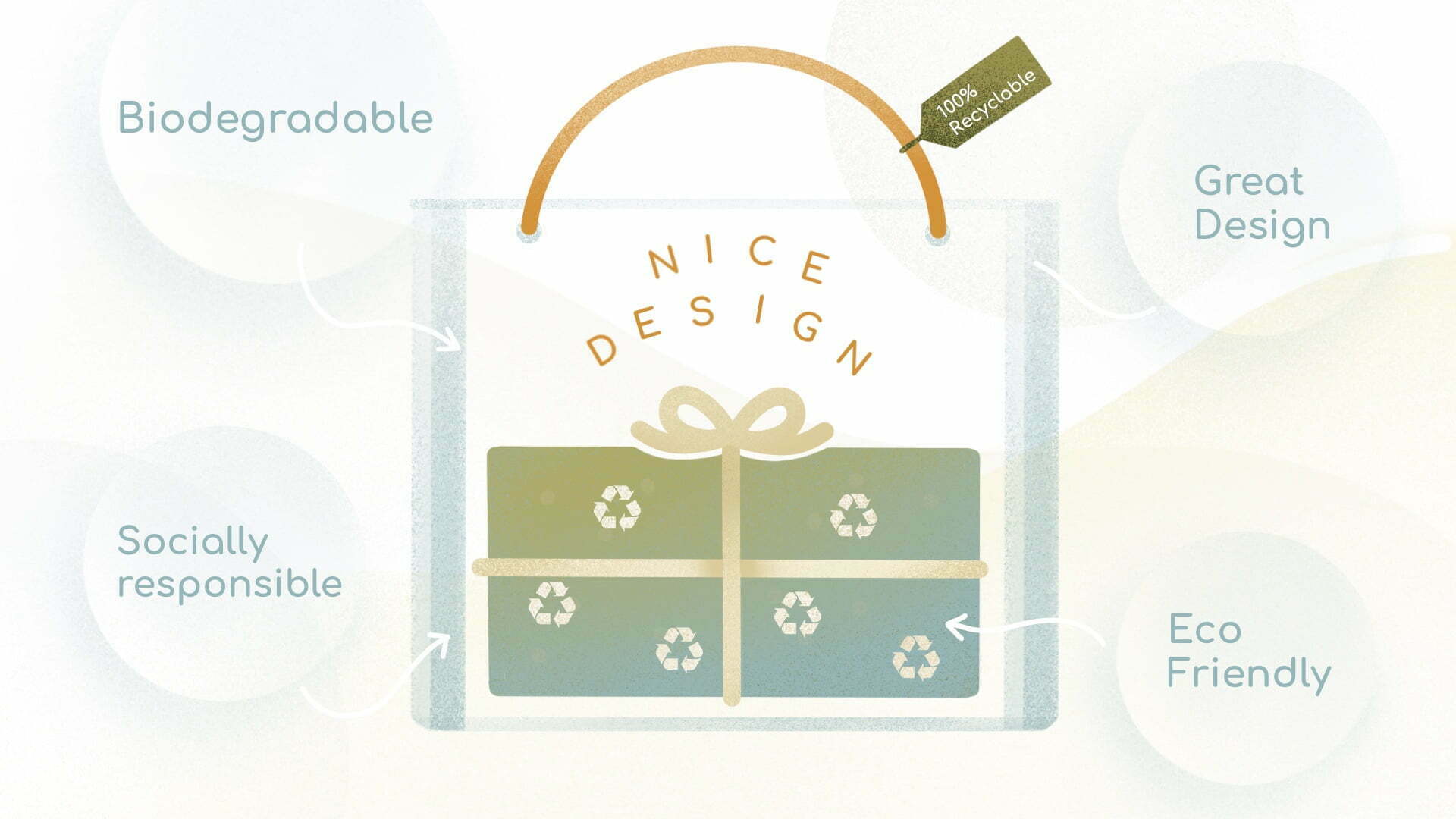

When someone first has an idea for a business, the last thing they are thinking about is
packaging, let alone eco friendly packaging, but it shouldn't be. In the world of E-Commerce, the package that a product comes in says much about your brand and it has a huge impact since it's the first impression a customer has when they first touch it.
While you can't control what a shipping company does with it, the condition, overall appearance, and protection provided, all play a factor consciously or subconsciously in how a consumer thinks.
Imagine it like getting a birthday present: the poly mailer comes with several boxes, but you noticed one of them is wrapped in colorful paper with a beautiful bow on the top. You instantly get excited and curious just because of the look of it. Even if the contents were the same, this is a way better present than receive one within a cardboard box.
When you think about it in those terms, choosing the kind of packages you use isn't so cut and dry, especially depending on your industry and the types of consumers you attract. For example, coffee brands require a specific type of eco friendly coffee packaging to ensure their coffee beans stay fragrant and fresh.
Packaging Follows Market Trends and Customers Needs
Traditional bags made from plastic barrier may be working now, but public
perception is changing, people are beginning to care more about sustainability, rethinking their personal habits, and companies must weigh their options and find a green and biodegradable packing solution that's both sustainable and works for them.
Why Plastic Packaging is not Biodegradable?
The question may have crossed your mind why all plastic aren't recyclable or biodegradable, considering they are made from a carbon-based material. The easy
answer is that they technically are; it is just that their manufacturing process makes it
sometimes take hundreds of years for that process to take place. The primary reason
that traditional barrier bags are not recyclable is that to improve performance, the bags
are made from a lamination of different materials, and the glue removal process makes
it economically unfeasible to recycle also, as most consumer packaging is not cleaned
before being recycled, so recycling companies usually throw all of it out.
Seeking New Packaging Solutions
Whether it is part of your corporate social responsibility efforts or simply trying to appeal
to environmentally savvy consumers, you wonder if green and sustainable packaging is a viable option for your company. By comparing traditional packaging and packages made from sustainable options in the same space, you should have the right information to weigh your options and come to a conclusion that is right for your business.
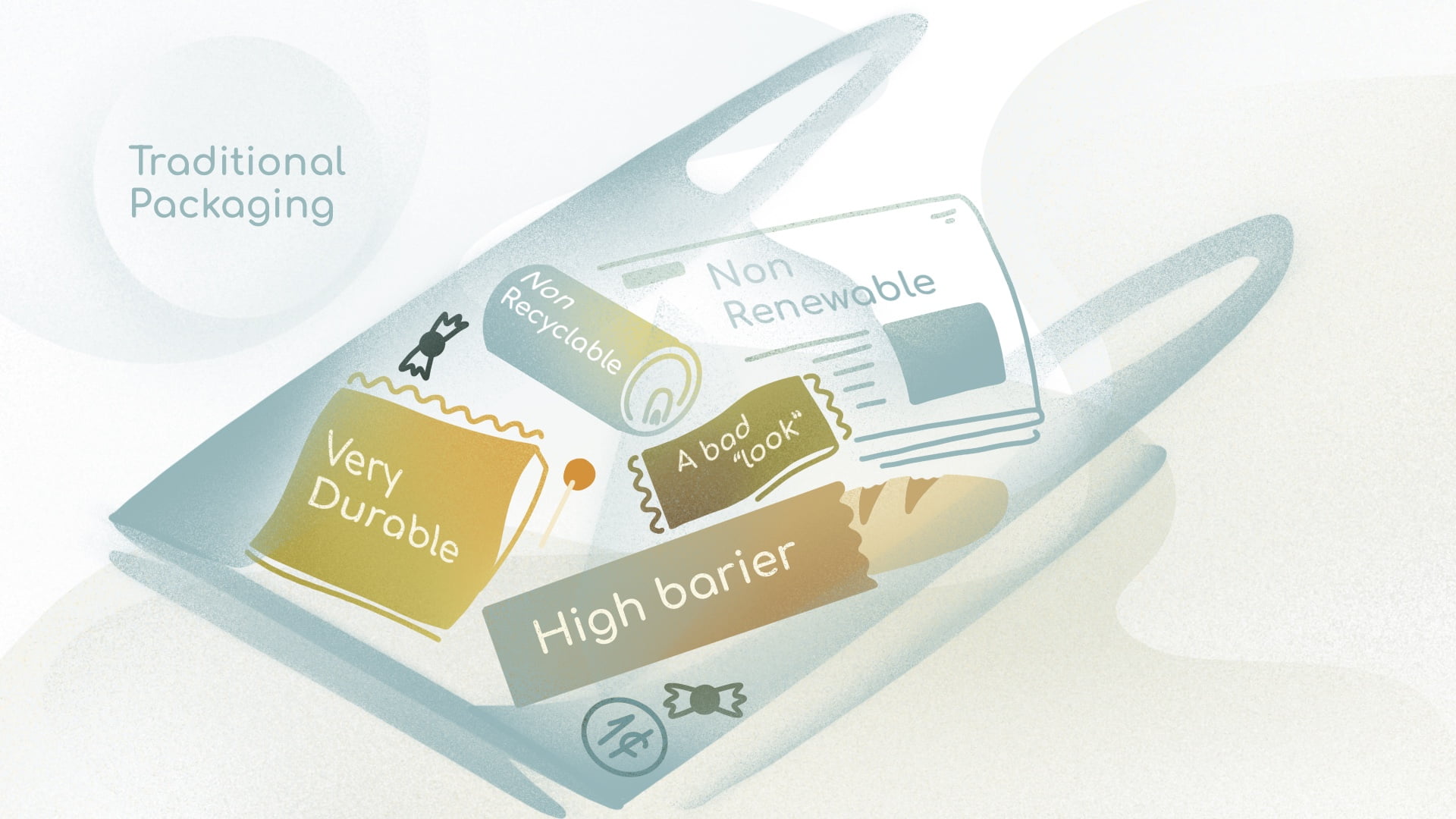

Pros and Cons of Traditional Packaging Materials
If it's not broken, some would say don't fix it, and these traditional plastic barrier bags have
been working for decades, so why change now? The world is getting much more Earth-conscious, leading consumers that care are seeking to do their part to conserve the planet. These pros and cons of traditional barrier bags shed some light on what made them so popular for so long and why they may no longer be the best option.
Advantages
Proven
These plastic bags have been used for years and have been proven time and time again to work.
They are more widely available because of their track record and their cost-efficiency.
Cost-Efficient
Traditional plastic bags are a cost-efficient way to protect your product during shipping, especially if you are shipping a lot
of volume.
Durability
Traditional plastic became the most popular packaging because they are flexible and lightweight but incredibly durable at the same time.
High Barrier Packaging
High barrier bags preserve products longer because there is a low transfer of oxygen between the inside and outside of the bag. Moisture transfer is also mitigated, and both can be mitigated further by adding oxygen and moisture absorbers to the bag. A high barrier doesn't only mean preventing liquid and gas transfer; it also means high tensile strength, which prevents tears and punctures.
Disadvantages
Uses non-renewables
Traditional plastic barrier bags are made from a non-renewable source, which means that every bag made uses more
resources.
Not Recyclable or Compostable Product
Since plastic is not recyclable or biodegradable, each bag creates waste that takes hundreds of years to break down, causing a massive environmental impact.
Public Perception
As consumers become more interested in conservation matters, using traditional plastic barrier bags may give customers a negative perception of brands that are using these materials.
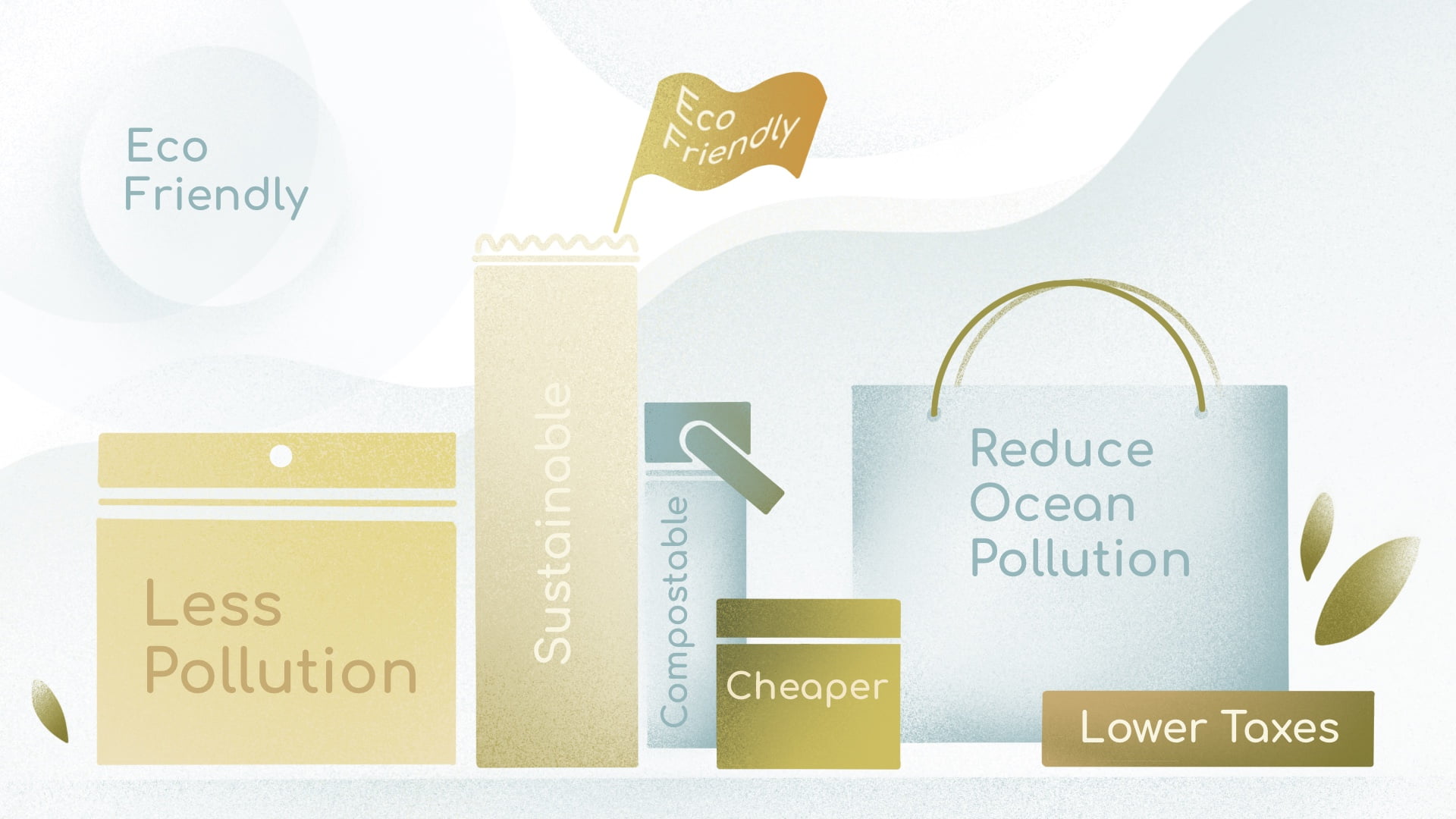

Pros and Cons of Sustainable Packaging and Eco Friendly Materials
Advantages
Public Perception
Businesses willing to spend a little more on sustainability and eco-friendly packaging will be viewed as socially responsible and likely have a better public perception. Customers that care about the environment have shown a strong interest in reducing the impact of their purchases. Sustainable packaging such as recyclable and biodegradable packaging improve consumers impression of your brand.
Enhanced Regulatory compliance
The EU, Canada and other nations have already started to move towards a more sustainable packaging future. They are in the process of enacting taxes on packaging which is not eco-friendly. "[T]he EU is moving to slap a tax on non-recycled plastic packaging in the new year."
Reduce Ocean Pollution from plastic products
Bags made from plastic and plastic waste are major contributors to ocean garbage. While recycling is a advantage, the process of recycling requires energy. The real future of packaging is biodegradable bags that will biodegrade either through industrial processes or in a land fill. Informed customers will love the fact that their bags can be composted.
Disadvantages
More expensive
Unfortunately, as is usually the case, using renewable resources, the materials used are more costly, so the price point of eco-friendly bags is higher in comparison to bags made from traditional plastic bags.
Less Barrier Packaging
While the technology continues to improve currently eco-friendly packaging like compostable and recyclable bags have a lower barrier from moisture and oxygen, which means a shorter shelf-life for packaged products. This can be mitigated with oxygen and moisture-absorbing additives and new coatings are being developed, currently if you need a high barrier packaging solution eco-friendly will not be as effective.
Less Durable
This packaging has less tensile strength, so it is not as immune to punctures and tears as traditional barrier bags. Common uses that need high tensile strength including protein powder, flours, and other granulated products. Also any product which is heavy, needs extra strength.
Some Eco Friendly Packaging Printing Limitations
The materials used for less expensive compostable barrier bags require printed materials to be printed directly onto the paper, limiting the design and colors one can use. Higher-end biodegradable packages do not have these same limitations.
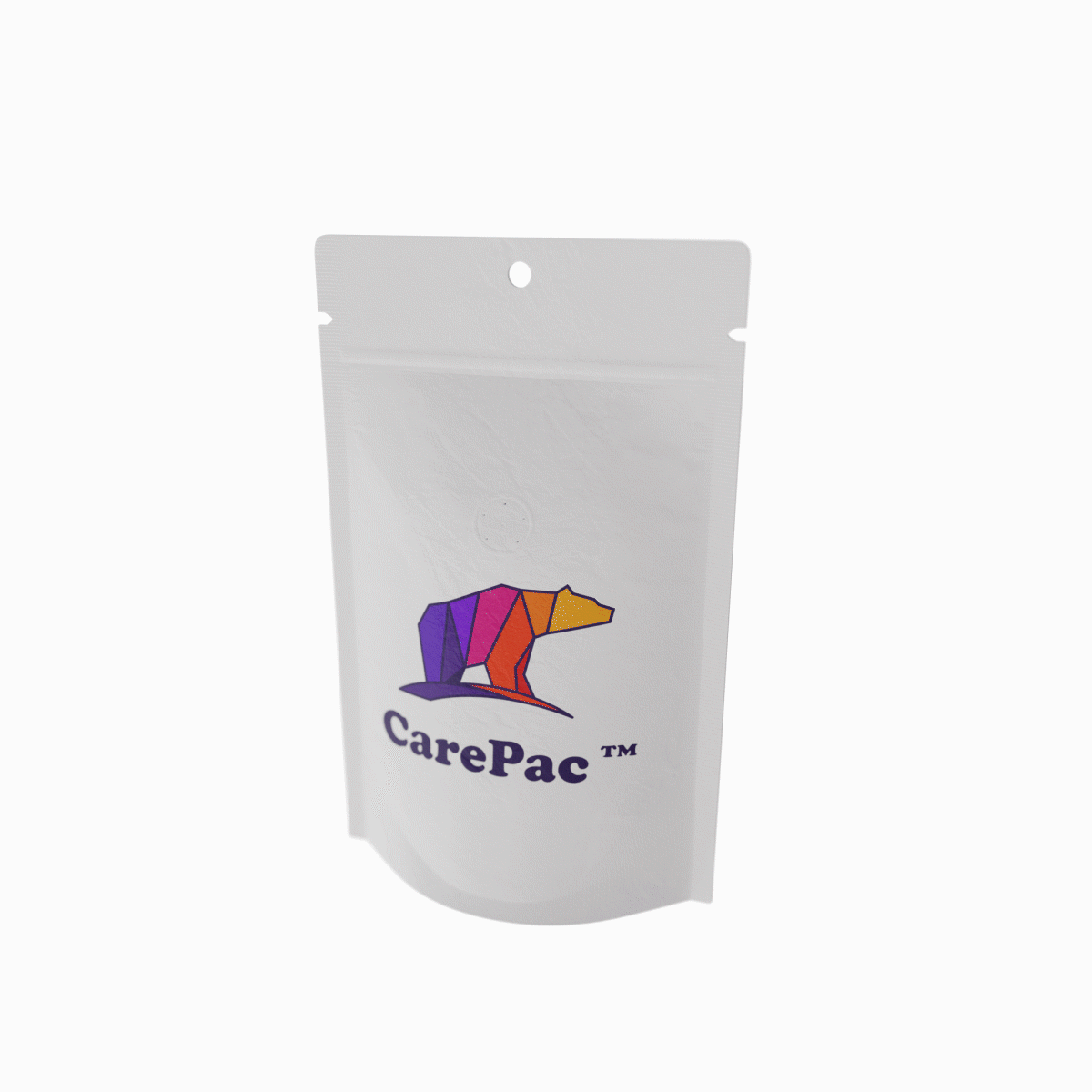
Pros and Cons of Sustainable Recyclable Packaging
Many of the advantages and disadvantages of recyclable bags are the same as compostable bags, with a few added considerations.
Advantages
Price
Because the materials are recyclable, these products are said to be less expensive than compostable bags.
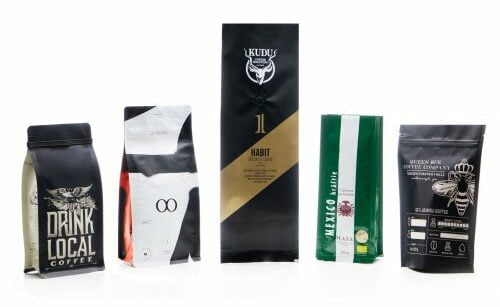
Disadvantages
Recyclable barrier bags look more like traditional barrier bags, so recycling facilities will often remove them from the recycling, and throw them away because they don't have the time or reason to check bags for a recyclable stamp.
4 Tips When Considering Eco-Friendly Packaging
1. Printing Needs
Since the package is what the customers see first, it helps to convey the brand's message. Having a package that offers lots of printable space facilitates this because the manufacturer can label the product and still be left with enough room to list the attributes that differentiate it from competitors. Square bottom pouches come in handy in such instances because they are fully printable on the front, back, bottom and sides. Custom eco-friendly poly mailers are also great options, as they are strong enough to hold up in the mail, won't take up unnecessary space in landfills and can be custom printed with the company's branding
2. Are Big Retailers Looking for It?
You have to dream big even if you are only a startup. One significant way to grow more quickly is by partnering with leading retailers. Walmart released a Sustainable Packaging Playbook to help companies improve their packaging methods. One of the nine metrics they consider for their eco-friendly packages is the recycled content. Amazon, on the other hand, wants packaging that is frustration-free and eco-friendly. If you can adhere to the guidelines that such leading retailers are looking for, your eco-friendly packaged products will boost your startup in no time.
3. Strength
The packaging material should be strong enough for your bag use. Tensile strength ensures it can resist a direct pull which is very instrumental in child food packaging. The tearing resistance, puncture resistance, impact strength, and bursting strength should match your bag use. Generally speaking most eco-friendly pouches will have a lower strength and tear resistance than the most advanced non-eco friendly bag material laminations.
4. Is it Recyclable or Compostable (it can't be both!)
Eco-friendly packaging material may be recyclable, compostable, or biodegradable, and most people use the terms interchangeably, which is wrong. Biodegradable materials must completely break down, decompose into natural elements and return to nature; some of these materials include corrugated cardboard. On the other hand, compostable materials provide nutrients to the earth thus can be added to compost piles. Since they require special composting conditions, ensure that the packaging materials meet those standards to make decomposing at home attainable.
Make the Switch to a more Eco Friendly Packaging
The extra upfront cost of choosing eco-friendly barrier bags can lead to higher sales and more profit in the long run. Thanks to their advantages, customers will love businesses that choose a socially responsible route for packaging your products. And some disadvantages to these products, like the fact that customers may not know that they are biodegradable or recyclable, can easily be rectified with a environmentally green design and information on the label about proper disposal and subtly notifying them that you have decided to be a more eco-conscious company. If you are ready to make the switch to sustainability, eco-friendly packages and get all the benefits that come with it, or if you have any other questions about the product or ordering, contact us today!
Tags

